Research Interests:
Research in my lab focuses on the anatomy, evolution, systematics, and biogeography of various marine mammals especially cetaceans. Projects currently being pursued include cranial growth in the gray whales: implications for phylogeny and ontogeny; anatomy, systematics, and historical biogeography of the extinct river dolphin Parapontoporia and developmental patterns of tooth formation and loss in fetal baleen whales with implications for mysticete evolution
My research has been funded by NSF (Systematic Biology).
A total
evidence analysis of pinniped phylogeny with an emphasis on the position of the
fossil taxon Allodesmus
Reagan Furbish's MS thesis project examined the controversial placement of the extinct pinniped, Allodesmus, on the pinniped phylogenetic tree. The total evidence analysis of pinnipeds will incorporate both morphological data and DNA evidence. Reagan also enjoys snorkeling with the sea lions in La Jolla, surfing, and board game nights. Reagan teaches human anatomy at several local San Diego colleges.
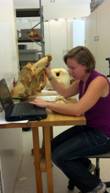
Ultrastructure of baleen in mysticete whales: evolutionary and ecological implications
Nicholas Zellmer’s MS thesis examined the ultrastructure of baleen plates and bristles in Mysticeti using various light and electron microscope based techniques. The data collected on baleen ultrastructure will be used to describe inter and intraspecific morphological variation and investigate the driving forces, such as phylogeny and ecology, behind species specific morphologies. Nick is a Ph.D. student in the Davis lab at University of Texas Galveston.
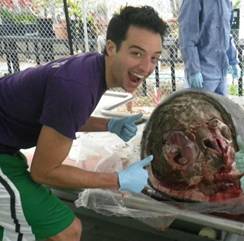
Form, function and phylogeny: a quantitative analysis of the cetacean tympanoperiotic complex
William Ary’s MS thesis uses vibrational analysis, finite element modeling, and geometric morphometrics to quantify the relationship between shape and function in cetacean earbones, then mapping that variation onto a phylogeny to see how shape varies within and between groups. Will is a Ph.D. student in the Goldbogen lab at Stanford.
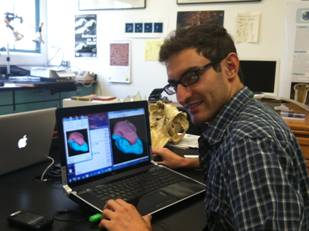
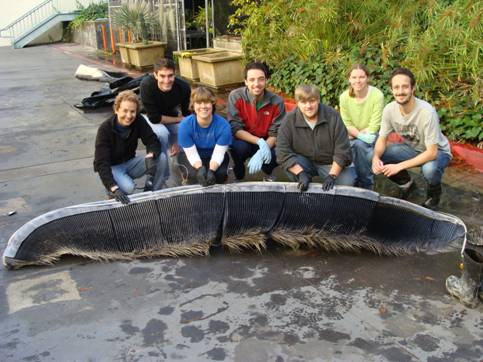
Fin whale baleen SDSU, 2012
(from left: A.. Berta, W. Ary, S. Kienle, N. Zellmer, E. Ekdale, J. Martin, J. El Adli (U. Michigan).
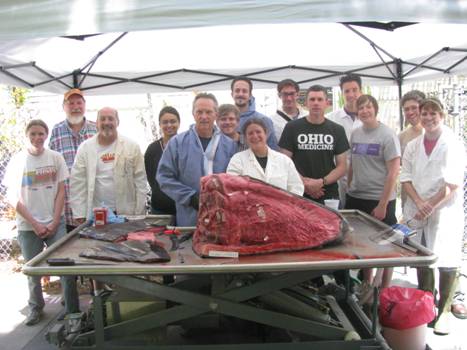
Gray whale head dissection SDSU, April, 2012
(from left: J. Martin, T. Cranford, K. Albertine (editor Anatomical Record), Witmer’s tech, T. Deméré, J. Reidenberg (Mt Sinai Medical School), E. Ekdale, J. El Adli, W. Ary, L. Witmer (Ohio Univ. Medical School) , N. Zellmer, 2 anatomy students and S. Kienle.
Former MS Students:
Peter Adam PADAM@nwmissouri.edu@ucla.edu
Peter’s
MS research involved mapping feeding and locomotor characters onto a phylogeny of pinnipeds. Peter earned a Ph.D. in 2007 from the University of California, Los Angeles and he is an Assistant Professor, Department of Biology, Northwest Missouri State University, Maryville, Missouri.
Celia
Barroso barroso_cel@yahoo.com
Celia Barroso’s
MS thesis (co-chaired by Ted Cranford) completed in Fall, 2010 involved investigation of the anatomy and evolution of mandibular shape across the Odontoceti using x-ray CT and geometric morphometrics (Barroso et al., 2012). The catalyst for this study was the recent discovery (Cranford et al. 2008) that sounds are received through an "open door" of bone on the posteriomedial aspect of the mandibles. Celia is working for an environmental consulting firm in the LA area.
Morgan
Churchill mmcjawa@yahoo.com
Morgan completed a MS in 2007. His research was a comprehensive morphological study of balaenoid phylogeny including extant species and several well known fossil taxa. He also evaluated the origin and diversification of balaenoids through time in the context of a phylogenetic framework (Churchill et al., 2011). Morgan is a postdoc in the Department of Anatomy at New York Institute of Technology, Westbury, NY.
Lisa Cooper lisa1225cooper@yahoo.com
Lisa completed a MS in 2004. Her research was an evaluation of the phylogenetic and functional significance of the forelimb in mysticetes. In addition to forelimb osteology, the soft tissue anatomy of several extant species were examined using dissection and histology. Lisa completed a Ph.D. in the Thewissen lab at Kent State University, Ohio and a postdoc in the Sears lab at University of Illinois, Champaign-Urbana, Illinois. Lisa is currently an Assistant Professor in the Department of Anatomy and Neurobiology, Northeastern Ohio Medical University, Rootstown, OH
Liliana
Fajardo-Mellor lulu_fajardo@hotmail.com
Liliana completed a MS in 2005. Her research was a comprehensive morphological study of phocoenids (porpoises) including extant species and a few well know fossil species. She also considered the origin and diversification of phocoenids through time within the context of the phylogenetic framework. Liliana completed a Ph.D. in the Department of Anatomy and Cell Biology at the Brody School of Medicine, East Carolina University, Greenville, North Carolina. She is currently a staff scientist at Centro Nacional de Investigaciones Oncologicas in Madrid, Spain.
Carrie Fyler caroline.fyler@uconn.edu
Carrie completed a MS in 2003. Her research was a phylogenetic analysis of monk seals using molecular sequence data. This phylogenetic framework was then used to consider the historical biogeography of the group. Carrie completed a Ph.D. in the Caira lab at the University of Connecticut. She is teaching at Montclair Kimberly Academy in Montclair, New Jersey.
Frances Johnson franjohnson03@yahoo.com
Fran completed a MS in 2007. Her research was a phylogenetic study of living South American foxes based on morphology (cranial, dental, postcranial, soft anatomical characters) using parsimony and Bayesian analyses. The origin and radiation of South American foxes was considered in an ecologic and evolutionary context. Fran graduated from Veterinary school at UC Davis and is a Veterinarian in the Davis area.
Cassie
Johnston Cassie.Johnston1@gmail.com
Cassie completed a MS in 2009. Her research was on the comparative anatomy and evolutionary history of suction feeding in cetaceans with emphasis on the gray whale. Cassie is employed by an environmental consulting firm in the LA area.
Mandy Keogh mjkeogh@uaa.alaska.edu
Mandy completed a MS in 2006. Her research involved comparative histological examination of the corpus callosum morphometry (relative size, fiber density) in representative odontocetes consider in both phylogenetic and functional contexts.
Mandy completed a Ph.D. from the University of Alaska, Fairbanks and is now employed as a Wildlife Physiologist at Alaska Fish and Game, Juneau AK.
Sarah
Stachura Kienle
Sarah completed a MS in 2013. Her research is a comparative analysis of the four feeding types (suction feeding, grip and tear feeding, pierce feeding, and filter feeding) employed in extant phocids (seals) using 3D morphometrics and comparative phylogenetic analyses. Quantitative feeding characters will be used to examine type(s) of feeding in stem phocids to understand the evolutionary origins of each feeding strategy. Sarah is a Ph.D student in the Costa lab at UC Santa Cruz.
Jessica Martin
Jessica will complete a MS in Fall, 2012. Her MS thesis investigates the evolutionary history of balaenopterid (rorquals) whales using morphology and divergence dating. Also, included is description and addition into the phylogenetic analysis of a new fossil balaenopterid from the Pliocene San Diego Formation. Jessica is employed as an instructor in the Department of Biology, University of Great Falls, Great Falls, Montana.
Michael
McGowen mmcgowen@med.wayne.edu
Michael (Rocky) completed a MS in 2005. His research mapped characters related to feeding morphology, behavior and diet onto a phylogeny of mysticetes. Rocky completed a Ph.D. in the Gatesy lab at the University of California, Riverside and is now a postdoc at the University of London.
Megan McKenna megan.mckenna@gmail.com
Megan completed a MS in 2005. Her research involved detailed morphological description of the melon among various lineages of odontocetes derived from CT images.
Melon structure and function was also considered in an evolutionary context (McKenna et al., 2011). Megan is completed a Ph.D. in Biological Oceanography from the University of California, San Diego (Scripps Institute of Oceanography). She is now employed as a bioacoustician for the National Park Service.
Rachel
Racicot rachel.racicot@gmail.com
Rachel completed a MS in 2007. Her research involved detailed morphological description of the pterygoid sinus among extant species and a fossil phocoenid derived from dissections and CT images (Racicot and Berta, in press). The pterygoid sinus is one component of a complex sinus system associated with sound production and reception. She considered the evolution of the pterygoid sinus among phocoenids and evaluated its phylogenetic and functional significance. Rachel is a postdoc at the Los Angeles County Museum of Natural History.
Amanda Rychel arychel@u.washington.edu
Amanda completed a MS in 2002. Her research used both mitochondrial genes and a nuclear marker to reconstruct phylogenetic relationships among mysticetes. Amanda completed a Ph.D. in the Swalla lab at the University of Washington and a postdoc at the UW. She is currently employed at Petrometrica, L.L.C., Somerville, MA.
Alex Sanchez alexandro69@sbcglobal.net
Alex completed a MS in 2007. His thesis investigated forelimb osteology and muscular anatomy of representative odontocetes in an evolutionary context. Alex is currently teaching part-time at Mira Costa College in southern California.
Breda Walsh bmckay@yahoo.com
Breda completed a MS in 2006. Her research was a comparative morphologic study of growth patterns in mysticetes based on ontogenetic stages of cranial ossification among extant species and several fossil species. Relative age determinations were based on sequence of cranial suture closure. Breda is employed at a research lab at UC San Diego.
Josh
Yonas yonas@me.com
Josh completed a MS thesis in Fall, 2008 on the anatomy and evolution of aquatic locomotion in walruses. He investigated fore and hind limb osteology and myology in the walrus using dissection, x-ray and MRI imaging. The evolution of locomotion in fossil and modern walruses and other pinnipeds was also considered. Josh graduated from Vet school in Pomona and is currently a Veterinarian in West Seattle, WA
Samantha Young youngsamanth@gmail.com
Samantha completed a MS thesis in Fall, 2011. Her project examined the anatomy (including SEM and morphometrics) and evolution of baleen. She also investigated baleen (bristle morphology) and its correlation with prey type. She is employed in the Education Department at the San Diego Zoo Institute for Conservation Research.
Representative Publications (last 5 years):
Berta, A. in
press. The Rise of Marine Mammals: 50
million years of evolution (Johns Hopkins University Press).
Berta, A., Lanzetti, A., Ekdale, E.G. Deméré. T.A. (2016). Evolutionary innovations
and ecology in mysticete
cetaceans: transition from teeth to baleen and raptorial to bulk feeding. Journal for the Society of Integrative and
Comparative Biology
Kienle, S.S, and A. Berta (2016). The better to eat you
with: The comparative feeding morphology of phocid
seals (Pinnipedia: Phocidae). Journal of Anatomy
228: 396-413.
Berta, A., J. L. Sumich and K. M. Kovacs (2015). Marine Mammals: Evolutionary Biology 3rd ed. Elsevier,
San Diego, CA 726 pp.
Berta, A. Editor
(2015). Whales, dolphins and porpoises:
a natural history and field guide. Univ. Chicago Press, IL, 288 pp.
Berta, A., S, Kienle, G. Bianucci, S. Sorbi (2015).
A re-evaluation of Pliophoca etrusca (Pinnipedia: Phocidae) from the
Pliocene of Italy: phylogenetic and biogeographic implications. Journal of
Vertebrate Paleontology
35(1): e889144.
Berta, A., E.G. Ekdale, N. Zellmer, T. Deméré, S. Kienle, M. Smallcomb (2015). Eye, nose, hair and throat: external
anatomy of the head of a neonate gray whale (Cetacea,
Mysticeti, Eschrichtiidae).
The Anatomical Record 298(4): 648-659.
Berta, A., E.G. Ekdale, T.A. Deméré, and J.S. Reidenberg (2015). Introduction to the anatomy of the head
of a neonate gray whale (Mysticeti, Eschrichtius robustus). The Anatomical Record 298(4): 643-647.
Ekdale, E.G., T.A. Deméré and A. Berta (2015).
Vascularization and ultrastructure of gray whale baleen (Cetacea,
Mysticeti), Eschrichtius robustus): implications for its origin and evolution.
The Anatomical Record 298(4): 691-702.
Young, S., T. Deméré, E.G. Ekdale, A. Berta and
N. Zellmer (2015). Morphometrics
and structure of complete baleen racks in gray whales (Eschrichtius robustus) from the eastern North
Pacific. The Anatomical Record 298(4): 703-719.
Berta, A., E.G. Ekdale and T.W. Cranford (2014). Review of the cetacean
nose: form, function and evolution. The Anatomical Record (invited
contribution), 297(11): 2205-2215.
Gatesy, J., J.H. Geisler, J. Changa, C. Buell, A.
Berta, R.W. Meredith, M.S. Springer, and M. R. McGowen
(2013). A phylogenetic blueprint for a modern whale. Mol. Phylog. Evol. 66(2); 479-506.
Racicot, R. and A.
Berta (2013). Comparative morphology of true porpoise (Cetacea:
Phocoenidae) pterygoid
sinuses: phylogenetic and functional implications. Journal of Morphology 274(1):
49-62.
Appeltans, W. and 100+ authors
including A. Berta (2012). The
magnitude of global marine species diversity. Current Biology 23(4):
2189-2202.
Berta, A. and M.
Churchill (2012). Pinniped taxonomy: review of the evidence for description of
currently recognized pinniped species and subspecies. Mammal Review 42:207-234.
Liwanag, H.E.M., A. Berta, D.P. Costa, M. Aubrey and
T.M. Williams (2012). Morphological and thermal properties of mammalian
insulation: the evolution of fur for aquatic living. Biological Journal of
the Linnean Society 104(4): 926-939.
Liwanag, H.E.M., A. Berta, D.P. Costa, S.M. Budge, and
T.M. Williams (2012) Morphological and thermal properties of mammalian
insulation: the evolutionary transition to blubber in pinnipeds. Biological
Journal of the Linnean Society 107(4): 774-787.
Barroso, C., T.W. Cranford and A. Berta (2012). Shape analysis of odontocete
mandibles: functional and evolutionary implications. Journal of Morphology 273:1021-1030.
Berta, A. (2012).
Return to the Sea: the Life and Evolutionary Times of Marine Mammals.
University of California Press, Berkeley, CA, 224 pp.
___________________
Annalisa Berta
Professor Emerita
Ph.D. University of California, Berkeley
Department of Biology
San Diego State University
5500 Campanile Dr.
San Diego, CA 92182-4614
(619) 594-5392
Email: aberta@mail.sdsu.edu
|